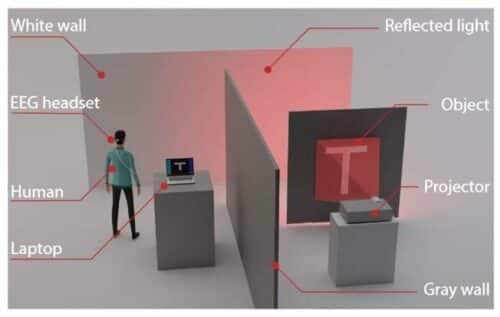Scientists have developed a way to computationally reconstruct images of an object hidden behind a wall with the help of Brain Computer Interface.

Researchers and entrepreneurs around the world have been trying to tap the potential of brain-computer interfaces for augmented cognitive abilities. Researcher Gao Wang and Daniele Faccio at the University of Glasgow recently demonstrated that it is possible to connect a human brain and a computer to perform simple computational imaging tasks. They used ghost imaging to computationally reconstruct images of an object hidden behind a wall.
Ghost imaging relies on the use of varying illumination patterns and the detection of corresponding light intensity values. Traditionally, the light intensity values are detected by a camera or other similar device, but some researchers have also tried using the human visual system as a sensor.
However, researchers in their work, used the human visual system for two purposes: it not only detected visual signals but also gave real-time feedback. The flickering light patterns were projected onto an object and reflected from a secondary white surface. The intensity values of the reflected light were detected by the participant’s visual cortex and captured as electrical signals by a headset with a single electrode. The signals were then processed on a laptop by an algorithm designed to reconstruct an image of the hidden object. At first impression the visual system might appear to be a different kind of camera.
For more efficient and higher-resolution imaging, researchers added an adaptive computational loop. With the help of real-time feedback given by the human visual system, they could modify the projected light patterns and “carve” out the less-helpful ones to improve both imaging speed and image quality. However, they found out in a follow-up experiment that when participants were asked to say or type on a keyboard the perceived light intensity while their brain signals were being monitored, the quality of the reconstructed images was reduced.
Researchers believe their paper lays the foundations for brain-computer systems to enable alternative computation forms within and beyond imaging. They also pointed out that there is more to be investigated, given the tension between conscious and non-conscious processing.
Reference : Gao Wang et al, Computational Ghost Imaging with the Human Brain, Intelligent Computing (2023). DOI: 10.34133/icomputing.0014






